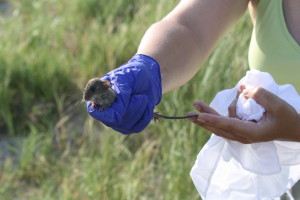Doctoral research on the Louisiana coast- Between March 2014 and July 2015, I collected information on the rodent and carnivore species living at a variety of barrier beach sites in Louisiana. Mostly I looked for coyote and raccoon tracks in the sand and hoped to catch marsh rice rats (it’s pretty depressing to set out 50 traps, bait them carefully with oatmeal, add a cottonball for a nice nest, and then find the traps all empty the following morning), but I also collected scat and information on vegetation. Now I’m working in the Leberg lab at the University of Louisiana at Lafayette to investigate the diets of these animals (yes, that means going through their scat, one sample at a time…). My hope is to better understand how these species fit into their environments and what variables will best predict their presence in a coast that is sinking.
Masters thesis research in Mongolia- I spent 4 months in 2011 collaborating with a Mongolian graduate student in Ikh Nart Nature Reserve. My focus was habitat use by Daurian hedgehogs (Mesechinus dauuricus)- basically I spent my nights following these animals around to see where they spent their time. It was amazing to see how far and how fast they traveled at night! It was also amazing to see the stars without light pollution. We attached VHS transmitters to subject animals and located them using antennae- each day I had my quest to locate animals, and each trek took me past amazing sights and animals. Ikh Nart is also the site of projects by researchers from the Denver Zoological Foundation, the Mongolian Academy of Sciences, and the University of Vermont, among other institutions.
Field research in northern Mexico- In 2010 I helped Camilo Sanchez Giraldo, a graduate student from the University of Mexico, track kit foxes and map prairie dog colonies- the former involved radio telemetry and the latter involved walking slowly with a GPS unit hanging from my neck (not exactly the most exciting work I have done…) We endured multiple vehicle problems, a tropical storm, and the defeat of Mexico before the final match of the World Cup. Seeing the foxes was a highlight for me, but the everyday work comparing current prairie dog colonies with previous maps really drove home the extent of prairie dog decline in the area.
Wood turtle research in southern New Hampshire- For one of my graduate school practica, I tracked wood turtles in south-western New Hampshire in 2010 and used the GPS data to map highly-used areas. Wood turtles (Glyptemys insculpta) are a species of concern in New Hampshire, and I can understand the interest in these animals- at one location we captured two very, very old males but could find no females- that seems like a problem…
Small mammal research in Bolivia’s rain forest- In 2009 I helped Margo Stoddard, a doctoral student at the University of Florida, with her investigations into the impact of different logging regimens on small mammal communities north of Santa Cruz, Bolivia. Our days were largely spent trapping rats and mice (opossums were scarce that season), taking physical measurements and giving each animal an ear tag for identification in the future. Some recaptures we got to know very well as they became repeat visitors to our traps. Waking up every morning to the sound of calling howler monkeys made me feel like I had been transported back to the Cretaceous, but the engine of the water pump reminded me that we were still very much in the modern age.





